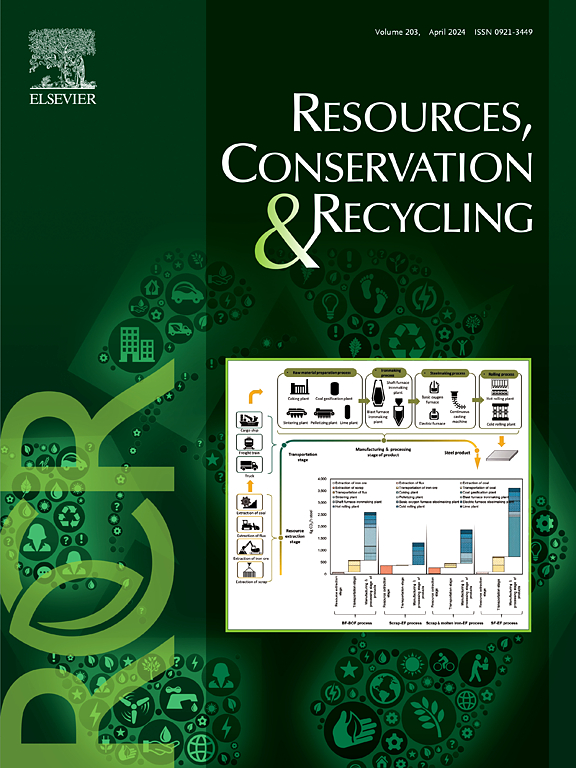跨越能源转型的风力涡轮机叶片报废管理:生命周期分析
IF 11.2
1区 环境科学与生态学
Q1 ENGINEERING, ENVIRONMENTAL
引用次数: 0
摘要
随着可再生能源需求的不断增长,全球风力涡轮机的使用量也大幅增加。随着这些涡轮机的使用寿命逐渐结束,管理其复合材料叶片所产生的废弃物成为了一项环境挑战。通过采用生命周期分析(LCA),该研究以澳大利亚正在进行的从化石燃料到可再生能源的能源转型为背景,评估了四种主要处理方案(填埋、机械回收、热解和溶解)对环境的影响。这项创新让人们更深入地了解到,在不久的将来,能源来源的转变会如何影响回收和处理方法的环保性能,从而为制定更具可持续性的废物管理策略提供指导。研究结果表明,溶解法由于具有生产回收碳纤维的潜力,对环境的影响最为积极(单项得分系数≈-500 MPt)。热解是下一个环境友好型方法,但略有不同。机械回收的结果似乎与这些方法相当,但回收纤维的质量有显著差异。敏感性分析还强调了用电量在环境影响中的关键作用,在溶解和热解过程中,用电量在人类健康损害评估中所占比例分别为 65% 和 86%,因此提倡减少用电量或过渡到可再生能源。最后,研究表明,根据不同的报废处理方案,在回收过程中过渡到使用可再生电力可将环境影响降低约 33-85%。此外,热解和溶解方法也有机会得到利用,因为在使用可再生资源时,这两种方法对环境的影响不相上下。在我们深入研究风力涡轮机叶片的创新回收方法时,我们看到了一个充满希望的前景,那就是一个更加可持续发展的未来,在这个未来中,认真的材料管理将为环境福祉做出贡献。本文章由计算机程序翻译,如有差异,请以英文原文为准。

End-of-life wind turbine blade management across energy transition: A life cycle analysis
The growing demand for renewable energy has led to a significant increase in the deployment of wind turbines globally. As these turbines reach the end of their operational lives, managing the waste generated from their composite blades presents environmental challenges. By employing life cycle analysis (LCA), the research assesses the environmental impacts of four major disposal scenarios - landfilling, mechanical recycling, pyrolysis, and solvolysis – in the context of Australia's ongoing energy transition from fossil fuels to renewables. This innovation provides a deeper insight into how shifting energy sources in the near future influence the environmental performance of recycling and disposal methods, offering guidance for more sustainable waste management strategies. According to the results, solvolysis shows the most positive impacts on the environment (single score factor ≈ -500 MPt) owing to the potential to produce recovered carbon fibre. Pyrolysis is the next environmentally friendly method, with a slight difference. Mechanical recycling appears to have comparable results to these methods, however the quality of recycled fibres has significant differences. Sensitivity analysis also underscores the critical role of electricity usage in the environmental impacts by 65 % and 86 % share of human health damage assessment in solvolysis and pyrolysis, advocating for its reduction or transition to renewable sources. Finally, the study shows that transitioning to renewable electricity in recycling processes revealed a potential reduction in the environmental impact by around 33–85 %, depending on the end-of-life treatment scenarios. There is also an opportunity to utilise both pyrolysis and solvolysis methods, as their environmental impacts are comparable when renewable resources are used. As we delve into innovative recycling approaches for wind turbine blades, there arises a hopeful prospect for a more sustainable future where conscientious material management contributes to environmental well-being.
求助全文
通过发布文献求助,成功后即可免费获取论文全文。
去求助
来源期刊

Resources Conservation and Recycling
环境科学-工程:环境
CiteScore
22.90
自引率
6.10%
发文量
625
审稿时长
23 days
期刊介绍:
The journal Resources, Conservation & Recycling welcomes contributions from research, which consider sustainable management and conservation of resources. The journal prioritizes understanding the transformation processes crucial for transitioning toward more sustainable production and consumption systems. It highlights technological, economic, institutional, and policy aspects related to specific resource management practices such as conservation, recycling, and resource substitution, as well as broader strategies like improving resource productivity and restructuring production and consumption patterns.
Contributions may address regional, national, or international scales and can range from individual resources or technologies to entire sectors or systems. Authors are encouraged to explore scientific and methodological issues alongside practical, environmental, and economic implications. However, manuscripts focusing solely on laboratory experiments without discussing their broader implications will not be considered for publication in the journal.
 求助内容:
求助内容: 应助结果提醒方式:
应助结果提醒方式:


